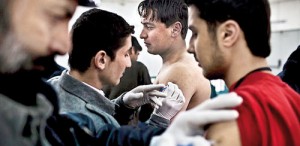Sunday Times 2
Time to take Asia’s hidden killer seriously
Globally, viral hepatitis kills an estimated 1.5 million people each year – a death toll comparable to HIV/AIDS. The chronic disease caused by hepatitis B and C viruses accounts for 78 per cent of all cases of liver cancer, which is the second most common cause of cancer deaths after lung cancer.

Copyright: Zackary Canepari / Panos
Despite this high burden, hepatitis wasn’t included in the Millennium Development Goals (MDGs) agreed in 2000. Jennifer Johnston, executive director of the Coalition to Eradicate Viral Hepatitis in Asia Pacific (CEVHAP), tells me that this was partly because viral hepatitis is largely a silent infection – the majority of those who contract it show no symptoms in the early stages of infection. People can live for decades with the infection having little impact on their health until it has developed into cirrhosis or liver cancer; and by then, the options for treatment are limited.
Johnstonadds that evidence about the disease’s substantial economic impact has only begun to emerge in the last few years. Crucially, strong evidence about the connection between viral hepatitis and liver cancer was unavailable when the MDGs were being discussed.
This lack of global attention and urgency has resulted in several countries making very little investment in the coordinated action needed to address hepatitis. But now the world is fully aware of how dangerous and costly the disease is – and it’s time to take it seriously.
World leaders need to urgently tackle viral hepatitis, starting with supporting its inclusion in the final draft of the Sustainable Development Goals (SDG). Without large-scale efforts to contain its spread and treat infections, experts estimate hepatitis B will kill 20 million people between 2015 and 2030 – currently, the number of deaths stands at 780,000 each year. And the death rates from hepatitis C alone are expected to surpass those of AIDS in a few decades.
Small successes
The past few years have seen pockets of success in raising awareness about the disease. In 2008, the WHO designated 28 July as World Hepatitis Day. And some countries have made great strides in encouraging prevention, diagnosis and treatment.
China, for example, has implemented national vaccination programmes. While it still has a high number of people infected with hepatitis B, the prevalence of chronic infection for people under 60 has dropped to 7.2 per cent in 2006 from 9.8 per cent in 1992, when routine immunisation ofinfants against hepatitis B began. This means that 24-30 million infections and 4.3 million deaths were prevented among children born after 1992, according to CEVHAP.
Last week, the inaugural Viral Hepatitis Summit (10-12 April), organised in Shanghai, China, by The Lancet Infectious Diseases, ran parallel with two oncology conferences, reflecting the recognition among health experts of the relationship between hepatitis and cancer.
But more must be done, starting with the SDG agenda. The draft SDG document mentions combating hepatitis among other diseases under Goal 3, which focuses on health. [2] The approved SDGs need to go further, by aiming to develop a global hepatitis elimination strategy like that for AIDS and tuberculosis.
First and foremost, including viral hepatitis in the SDG agenda will help raise funds for prevention and control efforts that involve numerous activities from education, monitoring and immunisation to screening people who could be infected and treatment for those who already are. Funding is also needed for research to drive evidence-based policies and to find a vaccine against hepatitis C.
Hepatitis target at risk
However, there are 180 potential SDG targets under discussion, with each vying for attention. So hepatitis might again be left out of the final version. In that scenario, the Asia-Pacific region stands to lose the most.
For reasons that are still unclear, the region shoulders the overwhelming share of the world’s burden of viral hepatitis. It accounts for an estimated 70 per cent of the global death toll, or about a million people. Over 100 million people are estimated to be infected with chronic hepatitis B. Countries in South-East Asia also report high rates of mother-to-child transmission. According to Johnston, when children are exposed to viral hepatitis before the age of five, there is an 80 per cent chance of the disease developing and causing liver damage later in life.
The hidden nature of the infection and poor education contribute to the high burden, but health prioritisation is a factor too: many people in the region spend most of their daily budget on food; health is at the bottom of their list of priorities and hepatitis is probably the least of their health concerns.
In addition, many of those infected cannot afford the healthcare they need. According to one study, the cost in China of treating infections that lead to cancer that starts in the liver ranged from US$3,000 to US$11,000 per person admitted to hospital for at least a week. This corresponds to up to four times the average annual household income in the sample – and even with health insurance, direct out-of-pocket costs exceeded 40 per cent of the patient’s disposable income.
According to CEVHAP, new direct-acting antiviral treatment can cure 95 per cent of hepatitis cases but costs over US$80,000 for a 12-week course, which is unaffordable to many people and governments in the region.
Despite the socioeconomic burden for South-East Asia, the WHO reported last year that only half the countries it surveyed in the region have a national action plan to prevent and control the spread of the disease. It is therefore in the interest of Asia-Pacific nations to band together and build a case for the world to keep viral hepatitis in the SDGs.
Courtesy scidev.net

